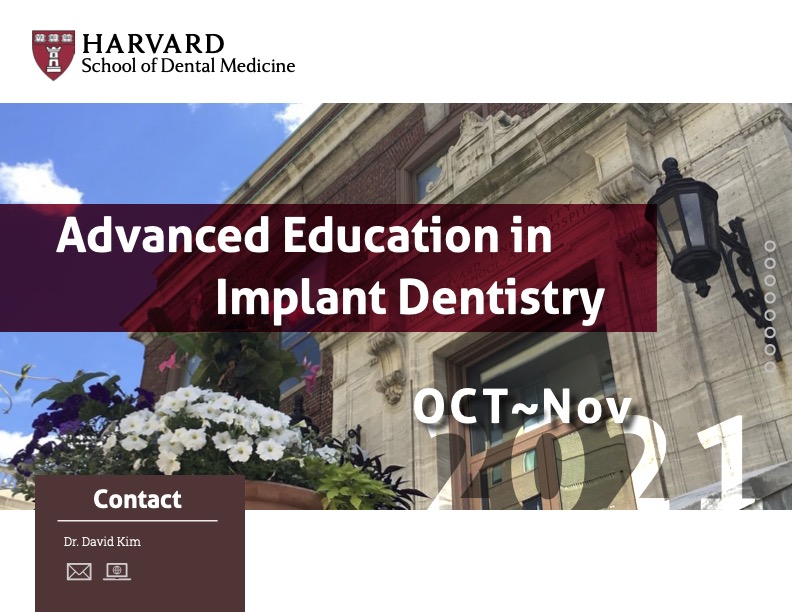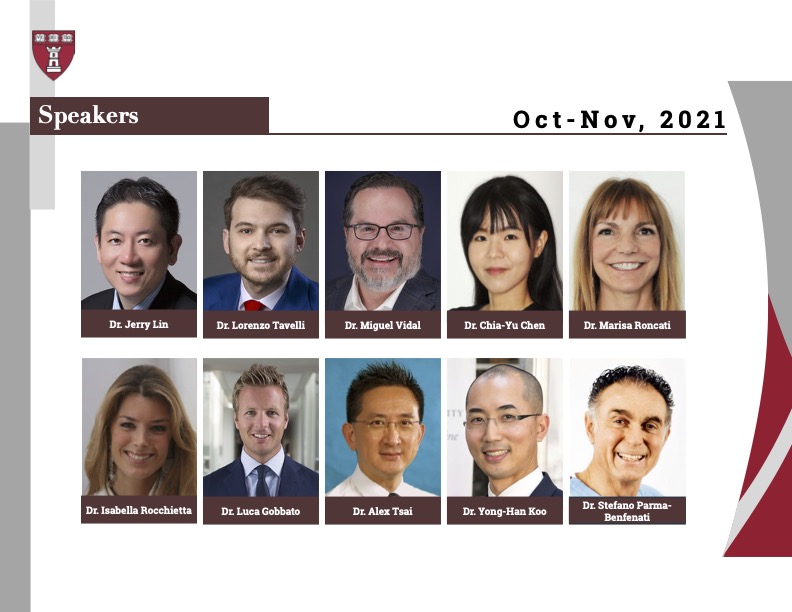Date:
Sat - Sat, Oct 16 to Nov 20, 7:00 - 10:00pm(台灣時間)
哈佛牙醫學院頗負盛名的進階植牙教育繼續課程即將在10月16日推出,連續五個週末,在台灣時間週六晚上7 pm 到 10 pm,網羅世界各地知名講師與教授,給學員最新與最豐富的進階植牙知識。
學程完成後將授與哈佛牙醫學院繼續教育結業證書。
* ADI會員專屬優惠:學會會員專案團報USD4600。
* 學校官網報名為:USD5200
Location:
Webinar Via Zoom
Course participants will have an opportunity to interact with talented periodontists, oral surgeons, and prosthodontists who are all highly skilled in treating challenging cases. Participants will be introduced to diverse treatment planning philosophies, as well as proven surgical and restorative techniques. Participants will become familiar with different diagnostic and treatment protocols that have been proven to be predictable and efficacious.
Overall Course Objectives:
1. To present innovative restorative and surgical techniques to treat complex cases and associated obstacles in achieving successful clinical outcomes.
2. To present current and emerging concepts in periodontics and Implant dentistry.
Speakers/Lecture Titles
Dr. Jerry Lin: Achieving Predictable Ridge Augmentation Outcomes
It has long been a challenge for dental clinicians to predictably augment the atrophic alveolar ridge horizontally and vertically for implant therapies. Various techniques have been developed to overcome this obstacle. This lecture will begin with the tissue engineering standpoints as well as biological considerations and further lead to the decision-making for utilizing proper surgical techniques for achieving ridge augmentation. Specific surgical interventions and techniques used to optimize the treatment outcomes will be addressed. This lecture will present various clinical cases and situations in which ridge augmentations have been accomplished with different surgical approaches. This lecture aims to deliver a solid biologic basis and provide clinical guidelines by which ridge augmentation can be predictably achieved.
Learning Objectives:
1. To identify different types of alveolar ridge defects.
2. To learn different techniques for obtaining ridge augmentation.
3. To make clinical decisions for treating ridge defects.
Dr. Isabella Rocchietta: Overcoming Challenges of Predictable Vertical Bone Augmentation
Dental implants have been successfully implemented as a routine therapeutic approach in partially and fully edentulous patients. Alveolar defects compromise the “prosthetically-driven” dental implant positioning unless a detailed planning is performed prior to the surgical phase. Many techniques have been described to augment alveolar bone, including autogenous block grafts, titanium mesh, distraction osteogenesis, guided bone regeneration, just to name a few. The use of Guided Bone Regeneration associated with non-autogenous scaffolds constitutes the standard of care of bone augmentation in all alveolar defects with or without implants, including the most severe vertical deficiencies. Choosing the correct therapeutic approach with the appropriate biomaterials is to achieve success in advanced GBR procedures.
Learning Objectives:
1. To understand the biological principle of GBR in its clinical applicability.
2. Learn tips and tricks on how to perform Vertical GBR in severe defects.
3. Learn how to avoid and manage complications in GBR.
Dr. Lorenzo Tavelli: Peri-implant Soft Tissue Dehiscence: Prevention and Treatment
The significance and idea of having certain amount of the keratinized mucosa at implant sites have been evolving and challenged over the years. Recently soft tissue management has become a key issue when placing dental implants and when dealing with soft tissue deficiencies around implants presented with thin mucosa. This lecture will discuss different treatment protocols to achieve the desired results.
Learning Objectives:
1. To understand the importance of the keratinized mucosa around implants.
2. To learn when to use a gingival graft and a connective tissue graft.
3. To learn about alternatives to autogenous grafts by using xenogeneic collagen substitutes.
Dr. Luca Gobbato: Soft and Hard Tissue Considerations in Demanding Esthetic Implant Dentistry
Since implant dentistry has become a common treatment for replacing missing teeth, dentists have been trying to mimic natural tooth morphology in order to achieve both functional results and to fulfill the patient's esthetic desires. What was considered the standard of care many years ago is not necessarily valid today. The criteria for implants include osseointegration and the possibility for optimal restoration. This presentation will focus on the management of the hard and soft tissue around dental implants and analyzing the characteristics of different periodontal biotypes. We will discuss basis concepts regarding immediate implant placement and guided bone regeneration proedure related to the esthetic zone before focusing on the soft tissue management. The purpose of the presentation is to provide a checklist that will guide the clinician developing a proper analysis and diagnosis for the successful esthetic result with implant supported restoration.
Learning Objectives:
1. To learn to identify different periodontal biotypes.
2. To learn to identify limiting factors regarding an optimal esthetic result.
3. To learn to select the ideal treatmetn option for different indications.
Dr. Miguel Vidal: Esthetic Anterior Dental Implant Restorations
As the predictability of implant therapy has increased, patients esthetic expectations levels have risen as well. The implant restoration needs to integrate seamlessly with the natural dentition. An understanding of proper treatment sequencing is critical to achieve a highly successful esthetic outcome. Intimate coordination between the precise surgical aspect and the restorative phase is paramount in achieving consistent esthetic restorations. This program will discuss how different treatment protocols can be employed to achieve the desired esthetic outcomes.
Learning Objectives:
1. Identify esthetic risk factors for natural teeth and implants
2. Understand the impact of treatment timing between the surgical aspect and the restorative outcome
3. Recognize the role of implant provisionals in creating and maintaining soft tissue contours for implant esthetics
4. Review the role of implant-abutment interface in prosthetic success
Dr. Alex Tsai: Surgical Foundation for Implant Dentistry
To achieve natural appearance is the primary goal when restoring implants in the aesthetic area. Therefore, precise and proper prosthetic and surgical planning will be required. Advanced technologies like intraoral scanning and computer guided surgery can be beneficial and easy to use. A key aspect like the prosthetic emergence profile will be discussed, and some useful surgical and prosthetic tips on how to reach predictable results in the management of the soft tissues will be explained.
Learning Objectives:
1. To understand the ideal emergence profile for implant restorations in the aesthetic area.
2. Learn how to determine implant position starting from the restoration’s profile.
3. To use intraoral scanning and computer guided surgery to obtain successful rehabilitation.
Dr. Jennifer Chen: 3D Technology in Periodontics and Implant Dentistry
With the advent of digital dentistry, clinicians find themselves inundated with new materials, hardware and software in daily practice. A thorough comprehesion of the technologies will help us integrate digital solutions to promote communication, as well as accelerating treatment processes and optimizing treatment outcomes. This presentation will allow dentists to become familiar with the digital workflow, with an emphasis on the implementation of the additive manufacturing, namely 3D printing technology in practice. The various 3D printing technologies (FDM, SLA and DLP) and their pros and cons will be discussed. Clinical scenario will be presented to demonstrte their respective indications.
Learning Objectives:
1. To understand the digital workflow for implant dentistry.
2. To discuss the various 3D printing technologes available in dentistry.
3. To be able to incorporate 3D printing in clinical practice.
Dr. Yong-Han Koo: Digitally Guided Complex Hard and Soft Tissue Augmentation Procedures
Guided bone and tissue regeneration techniques have revolutionized clinicians’ abilities to treat a wide array of clinically challenging situations, ranging from mild to severe bone and soft tissue defects. Although many cases enjoy long-term success, complications related to soft and hard tissues supporting dental implants have become increasingly prevalent. This presentation will discuss efficient and precise methods of identifying various risk factors and prognosis at the time of initial consultation utilizing advanced digital technologies. It will also address surgical treatment modalities to restore form and function that satisfy the evidence-based criteria for long-term stability. Esthetically and clinically demanding areas of the anterior maxilla, as well as the posterior mandible, will be emphasized. Complications and their management will also be discussed.
Learning Objectives: A
1. Understand the key determining factors for long-term success criteria: Survival vs. Success.
2. Describe Stage I, II, and III surgical protocols.
3. Perform various surgeries using digitally guided bone and soft tissue regeneration techniques for high predictability in a minimally invasive manner.
4. Utilize growth factors (Emdogain, PRGF, and rhBMP-2) to enhance both the alveolar bone and soft tissue defects and overcome dental implant complications.
Dr. Marisa Roncati: Peri-Implant Diseases: Differentiated Non-Surgical Protocols
The non-surgical approach has proven to be quite effective in mucositis, combining adequate home care with appropriate mechanical instrumentation. Conversely, in peri-implantitis with progressive and irreversible bone loss, the site-specific non-surgical phase should always be the initial treatment of choice. Often, we are obtaining unpredictable and unsatisfactory results, which can compromise severely ailing implants' survival. Some patients may not accept surgical management, either for justifiable health reasons or due to psychological and/or economic considerations. Under these conditions, the dentist has the option to evaluate the potential of a non-surgical approach in a patient who wishes to or must avoid periodontal surgery. Numerous clinical images, drawings, and videos related to clinical cases with follow-up will illustrate how to obtain an effective decontamination/detoxification of the implant surface with innovative materials for multiple antimicrobial approaches. This will be demonstrated by applying differentiated protocols used to maintain peri-implant tissue health and in the treatment of mucositis and/or peri-implantitis. The long-term success of any peri-implant treatment, carried out properly, depends essentially on the patient’s degree of cooperation, both in adhering to the recommended recall schedule and in daily proper home care.
Learning Objectives:
1. To prevent peri-implantitis and to plan for long-term success.
2. To be capable of implementing differentiated protocols to treat mucositis or peri-implantitis.
3. To provide a maintenance program for each patient emphasizing oral hygiene to achieve long-term oral health.
Dr. Stefano Parma Benfenati: Surgical Manageent of Dental Implant Complicatons
Different dental implant complications do arise, such as malpositioned implants with and without biologic damages, gingival recessions, and catastrophic clinical outcomes. The treatment of these severe complications requires complex multidisciplinary treatment associated with a high biological price for the patient. In addition, peri-implantitis affected implants in areas of high esthetic areas are characterized by loss of supporting bone and very often associated with soft tissue instability, with further damage and unavoidable complications. Early intervention and correct diagnosis are crucial factors; however, very limited scientific evidence are available to select an adequate surgical treatment plan. Several clinical cases with a long-term survival follow-up, strategies, clinical protocol, and techniques with a ‘‘step-by-step’’ approach will be presented.
Learning Objectives:
1. To understand the importance of a correct and early diagnosis.
2. To discuss the various therapeutic solutions and their biological implications.
3. To learn the different therapeutic solutions for the treatment of malpositioned implants ii) gingival recession treatment iii) how to manage catastrophic dental implant complications.
4. To discuss the predictability and longevity of clinical results.

 也歡迎加入學會成為正式會員,同享福利!
也歡迎加入學會成為正式會員,同享福利!
